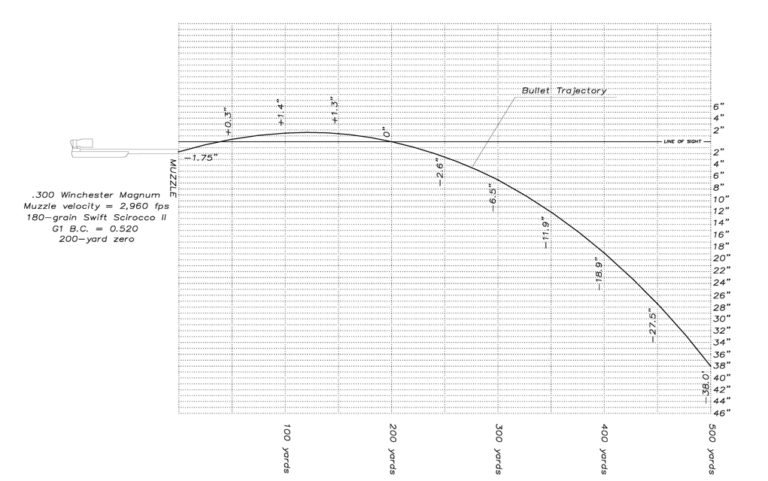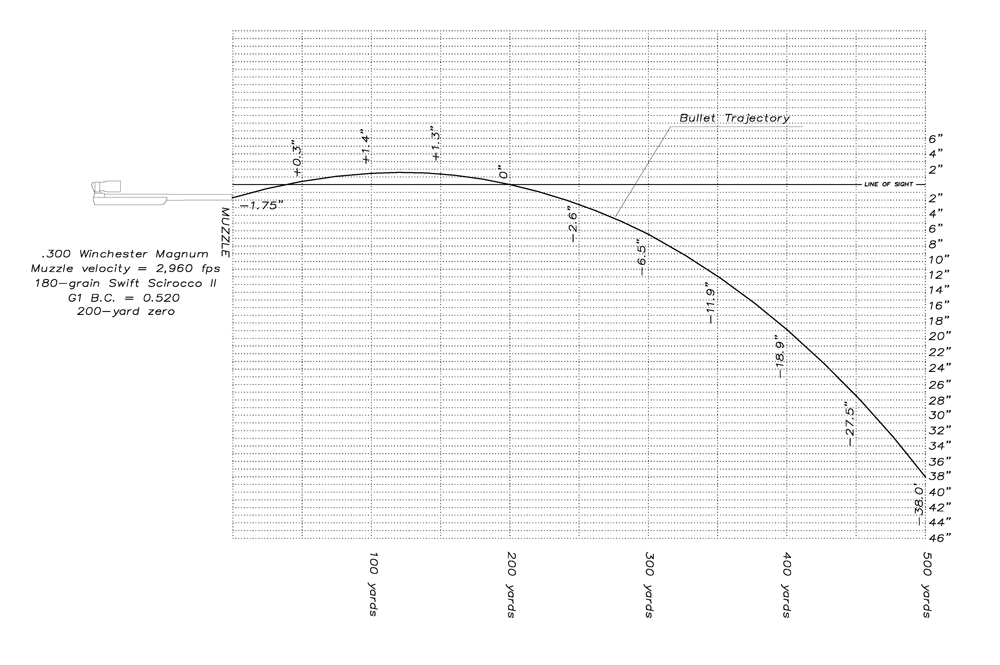

Exterior Ballistics is simply the portion of a bullet's flight once it leaves the muzzle until it hits the target. It is important for shooters to understand the forces at play during this window, if they have their sights set on accuracy.
The primer has been struck, the powder burned, and the bullet acted upon in a most violent chain of events. Yes, our proud little metallic fledgling has left the nest! Into free air it is sent, rotating rapidly, on its course to an unknown destination. Immediately, a multitude of alien forces begin to act upon it as it rolls with the punches and reacts accordingly.
Obviously, not all bullets are built in the same fashion, and each of them react differently to the forces of their particular environment. Some are sleek and streamlined, like a fighter jet, designed for the utmost speed and efficiency, while others are built like a tank, square and strong, to breach the strongest defenses. As with mechanized implements on the battlefield, the two extremes in bullet design use completely different means to the same end, and have different applications.
Exterior ballistics deals with that portion of the bullet’s flight from the moment it leaves the muzzle until it impacts its target — whether that target is paper, steel or flesh. In a handgun, especially a defensive arm, the flight of the bullet is rather short, and the atmosphere and laws of physics have less opportunity to influence things.
In a high-powered rifle, these forces have plenty of time to show their effects. To be able to put that bullet precisely on target, you need to fully understand how the bullet will react to your environment at a wide variety of ranges. Entire lifetimes have been spent in pursuit of the accurate prediction of bullet trajectories. While the answers are out there, the science of ballistics is constantly evolving, and our ability to quantify and predict the values associated with the bullet’s path is improving all the time.

There are scientific terms associated with exterior ballistics, and they can be confusing at times. The most prevalent term we’ll need to understand is ballistic coefficient, or BC as we’ll see it abbreviated, a term that describes the bullet’s ability to resist the effects of atmospheric drag and wind drift, as compared to the base models of bullet shapes as defined by the Commission d’Experience de Gavre.
That was where a series of tests were performed at the Aberdeen Proving Ground, Maryland, by the U.S. Army in the early 1880s, and the G1 bullet form (G in honor of Gavre) was adopted as the model for comparative purposes. Almost all of today’s bullets are labeled with a BC based on the G1 model, although there are newer and different models that better serve the shooter (we’ll get into detail about that later in this section).
The accuracy of a particular firearm is most often measured in the arc subtended by a minute of angle, abbreviated as MOA. One minute of angle is 1/60th of one degree on a circle, and is equal to 1.047 inches at 100 yards. For our general purposes, assume that figure as 1 inch. Thus, one MOA is 1 inch at 100 yards, 2 inches at 200 yards, 3 inches at 300 yards, and so forth.
A rifle that is said to shoot MOA will print a group of shots that measure no more than 1 inch of extreme spread at 100 yards. Since group size is measured in a function of a projecting cone, the further the distance the target is from the muzzle, the wider the arc subtended by that angle. For hunters facing shots inside of 400 yards, an MOA rifle should print a group measuring four inches at the 400-yard mark.
Wind drift is the effect of any crosswind during the bullet’s flight. It is a tricky proposition learning to ‘dope’ the wind, but it is necessary to hit distant targets in real world situations. Wind will certainly blow a bullet off its course in a horizontal direction, but in certain situations it will have a vertical effect as well. Wind drift is typically represented in inches, but I’ve seen it in MOA as well. I personally prefer inches, but the two are easily converted. MOA is an important value for precisely adjusting telescopic sights.

Now, the trajectory of a bullet is based on more than one factor. Shortly after Sir Isaac Newton had his noodle rocked by that fateful piece of fruit (I’m thinking back to the wonderful Schoolhouse Rock cartoons of my youth), he did his best to explain the laws of gravity. The resultant accepted formulae state that, with the effects of atmospheric drag aside, all small bodies will fall to the earth at the same rate. This applies to projectiles as well. Whether fired at Mach III or simply dropped from your hand, the bullet falls to the ground in the same amount of time.
When a rifle is described as flat shooting, it is because it generates a higher than normal muzzle velocity, and the bullet is allowed to cover more ground before gravity pulls it earthward. The flattest shooting cartridges have the shortest time of flight (abbreviated TOF), so that the represented curve of the bullet path looks much flatter than the slower cartridges. Combine this gravitational effect with the effects of air drag, crosswind, and atmospheric conditions, and your projectile has much to overcome before it tears out the bullseye. You can now see why the science of ballistics is so in-depth.
There is a common misconception about trajectory that can be easily misconstrued from looking at the trajectory curves printed on the back of ammunition boxes. I’ve had many people argue until they were red in the face that a bullet rises once it leaves the muzzle, and starts to drop in a rainbow-like curve. That, dear reader, is simply not the truth, though it is necessary to adjust the way you use your firearms to have that be the end result.
If you were to hold any firearm so that the line of the bore were perfectly level (perpendicular to gravitational pull), your bullet would immediately start to drop below the line of the bore, essentially never striking a target exactly where the bore was aiming, irrespective of distance to the target. There would be some (perhaps minuscule) gravitational pull. Coupled with that idea, the manner in which you sight your firearms — whether with iron sights or telescopic sights — requires your visual plane be elevated at some distance above the bore line.
So, with those two factors involved, you must elevate the bore at a certain angle upward so that the bullet path and the visual plane will cross at two specific distances. The flight of the bullet must begin below the visual plane, then rise above it, and finally cross the visual plane once again after gravity and air drag have had their time to act. The distance at which the bullet crosses the visual plane for the second time is commonly referred to as ‘zero.’ A rifle zeroed for two-hundred yards means that the curve of the bullet path will leave the muzzle, cross the visual plane at 25 to 50 yards (strongly dependent on the type and velocity of cartridge you’re using), rise a small distance above the line of the visual plane, and meet the line of the visual plane at exactly 200 yards from the muzzle.

The farther the bullet gets from the muzzle, the more drastic the effects of the atmosphere and gravity become. That ballistic coefficient or BC figure — again, the comparison of the ability of your bullet to overcome air drag and wind drift with a particular model — is not a static figure; it changes over a range of velocities.
Often when the bullet manufacturer lists a BC figure for their bullet, it is in comparison with the G1 bullet model (a model that simply doesn’t best describe most of today’s bullets) as well as being an average of the changing BC over a variety of distances and velocities. While it serves as an approximation, there are better means of representing the highly specialized bullets of the modern era, the ones that truly require an accurate representation as they are used for long-distance work.
As a reminder, the sectional density, or SD, is a ratio of the bullet’s mass (weight) to its bore diameter. While we’ll be using this characteristic much more in the terminal ballistics section, for the purposes of external ballistics your bullet’s SD figure is an important part of deriving its form factor, in comparison to a G1 or G7 bullet model, and that in turn is used for the derivation of an accurate BC.
There are also the rotational effects of a bullet that need to be taken into account for true long-range accuracy. That same spin that the barrel’s rifling imparted on the bullet not only keeps it stable in flight, but causes an effect known as spin drift at extreme ranges. If you’re serious about long-range shooting, you’ll want to know how to calculate and adjust for it.
This article is an excerpt from the Big Book of Ballistics.

Next Step: Get your FREE Printable Target Pack
Enhance your shooting precision with our 62 MOA Targets, perfect for rifles and handguns. Crafted in collaboration with Storm Tactical for accuracy and versatility.
Subscribe to the Gun Digest email newsletter and get your downloadable target pack sent straight to your inbox. Stay updated with the latest firearms info in the industry.

![Best Concealed Carry Guns In 2025 [Field Tested] Wilson Combat EDC X9S 1](https://gundigest.com/wp-content/uploads/Wilson-Combat-EDC-X9S-1-324x160.jpg)


![Best 9mm Carbine: Affordable PCCs [Tested] Ruger Carbine Shooting](https://gundigest.com/wp-content/uploads/Ruger-Carbine-Shooting-100x70.jpg)
![Best AR-15: Top Options Available Today [Field Tested] Harrington and Richardson PSA XM177E2 feature](https://gundigest.com/wp-content/uploads/Harrington-and-Richardson-PSA-XM177E2-feature-100x70.jpg)

Commission d’Experience de Gavre were tests carried out in France from 1873 to 1898. These produced a table which showed retardations for each velocity, rather than a formula to calculate air resistance. This became known as the Garve Function. Later tests, carried out at Aberdeen, slightly modified the table and abbreviated it to the G-function and eventually simply G.